Since it was introduced, Cyber Monday—the online shopping holiday that takes place the Monday after Thanksgiving—has been one of the biggest online shopping days of the year, delivering record-breaking sales year over year.
To make the most of this annual shopping event and the rest of the season, adopting Cyber Monday strategies is crucial for retailers, whether you have a brick-and-mortar store and website or sell exclusively online.
Here are our recommended small business Cyber Monday strategies and marketing tips for improving the shopping experience and driving sales.
1. Create an Exclusive Deal for Cyber Monday
The very first thing you need to do to start marketing around Cyber Monday is to determine the promotions you will offer. With rising inflation driving the cost of products upward, finding the balance between offering deep Cyber Monday discounts and maintaining profitability is key for retailers this year.
When considering which products to put on sale, there’s no one-size-fits-all answer. Some options include:
- A flagship item (often deeply discounted by up to 50% off or more) to generate buzz and bring in qualified traffic
- Slow-moving items and/or less popular product categories
- Popular gift categories, like clothing, toys, and electronics
- Your store’s entire catalog
Find more ideas in our guide to pricing strategies.
If your margins don’t allow for discounts or sales, consider a different creative promotion, like bundle deals, buy-one-get-one, free gift with purchase, or free shipping, which we discuss below.
Bundle Deals
Try offering themed product bundles Product bundling is offering several products or services for sale as one combined product or service package. with related items—these can also function as a mini gift guide. You can also use bundles as a way of pairing popular items with slower-moving inventory to help clear out excess and seasonal products.

Pink Moon offers a bundle deal on skincare items.
Buy-One-Get-One
You can also consider offering a buy-one-get-one deal where consumers can get two of the same item for the price of one. BOGO deals, like bundles, are an opportunity to move dated, out-of-season, or dead stock. Customers will be more inclined to purchase these items when they are on sale, even if they aren’t selling at full price.
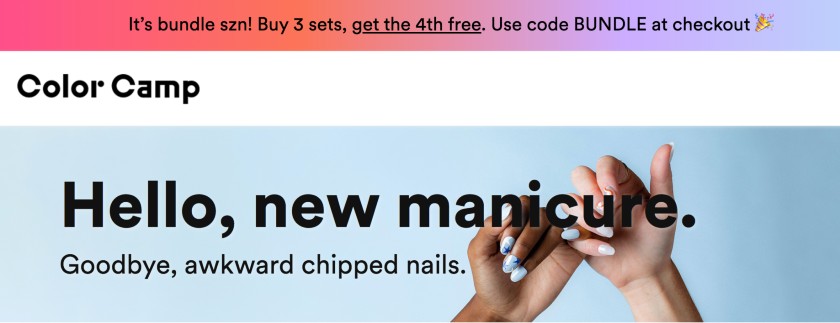
Color Camp offers a fourth manicure set for free when customers purchase three.
Free Gift With Purchase
With the free gift with purchase strategy, either with a specific purchase amount or with the purchase of a specific product, you offer customers a free gift. The gift can be a mystery, a set item, or you can give shoppers the opportunity to choose from several items.
Alternatively, you can include product samples as your free gift with your purchase. This gives customers the chance to discover new items in your catalog, encouraging future sales.
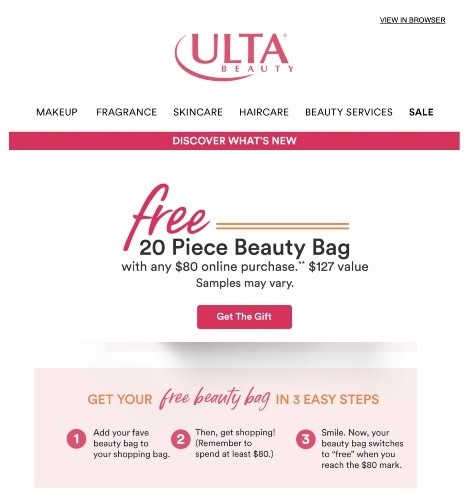
Ulta Beauty offers a free 20-piece beauty bag with $80 purchase in an email campaign
Free Shipping
If your store normally charges for shipping, try offering free shipping on certain items or at a certain order price point (spend $25, get free shipping) as your Cyber Monday promo.
Make the threshold to qualify for free shipping at or just above your average sale. Providing free shipping at a certain order amount will help bump up potentially low-value orders, increase basket size, and increase customer satisfaction.
Learn how to offer free shipping on your orders without sacrificing profit margins.
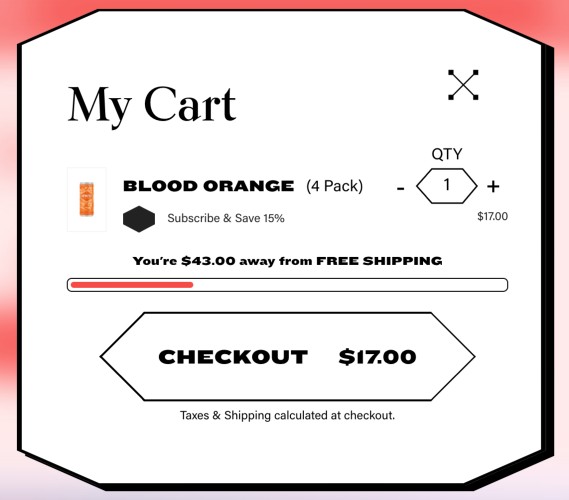
Spritz Society offers free shipping for orders over $60, and features a visual aid to show customers how close their basket is to reaching the threshold.
TIP: When executing promotional Cyber Monday ideas, it is best to know if your ecommerce platform can implement it seamlessly. Deals like bundles, free shipping, product recommendations, and more can be easily done in an ecommerce platform like Shopify. Our picks for the best ecommerce platforms mostly have built-in features that make it easy to offer one or more of these promotions on your site and push them out across other online sales channels like Amazon and Facebook.
2. Advertise Effectively
Now that you have a great deal for Cyber Monday, it’s time to do some Cyber Monday advertising. To get the results you want, shoppers need to know about your store and your Cyber Monday sale. To do that, you need to advertise where your shoppers are found and would normally look around for deals. For a full guide on this, read our article on retail marketing ideas.
Before you advertise, though, we recommend you build a dedicated landing page and create a gift guide for your Cyber Monday deals.
- A dedicated Cyber Monday landing page
A landing page is a single web page created to offer one clear call to action (CTA) that results in higher conversion rates than other web pages.
: Part of effective Cyber Monday advertising is building a slick-looking and on-brand landing page that pushes shoppers to purchase from your store. To learn how, read our guide to creating a landing page. - A retail gift guide: Choosing the right gift is a common struggle for holiday shoppers. Giving customers some much-needed gift inspiration can help encourage them to buy targeted products and make the overall purchase process more hassle-free. To learn how to make one, read our guide to creating a gift guide.
Consider doing your Cyber Monday advertising in the following channels:
Create Buzz on Social Media
Shopping-related research on social media has shot up since 2015. These platforms have even surpassed search engines among Gen Z, with 48% of them preferring to search on social networks than on search engines (44%). If your brand isn’t active on social media or doesn’t maintain a social media presence, you are clearly missing out.
- If you don’t already have a Facebook business page for your retail store, the pre-holiday season is an excellent time to set one up. Once you have your Facebook business page, you can even sell items directly through Facebook—Facebook is the leading social platform for online purchases, so you can make the channel a one-stop shop for your customers.
- As a highly visual platform, Instagram is an excellent channel to showcase your products in their best light as well. Like Facebook, Instagram is also shoppable.
Start posting your promotions on social media as early as possible. You can make your own marketing materials or hire someone to make it for you. If you are a one-man team or running a small team, leverage AI content writing tools and social media schedulers to help keep a regular content publishing cadence among your social channels.
If you want to do paid social media advertising, you can read our related guides below:
- How to Advertise Your Business on Facebook (Beginners Guide)
- Facebook Ads Cost in 2023: Stats, Trends & Return on Spend
- 15 Marketing Strategies for Facebook Pages in 2023
TIP: Work with influencers and include influencer marketing campaigns in your Cyber Monday promotions—it can drive revenue by up to 6.5 times. Influencer marketing isn’t just for big brands—it’s also an excellent way for your small businesses to reach niche audiences. You can work with niche influencers (they are usually less expensive) who create content for your specific target audience on blogs or social channels like Instagram and YouTube.
Increase Visibility With SEO
SEO or search engine optimization refers to all the measures you take to make your website appear in the search engine results page for your desired keywords. Since shoppers tend to do their product research online through search engines and social media, with search engines taking the larger share all internet users, making sure your Cyber Monday offers get into top search results is a great way to attract potential customers.
While it’s difficult for small businesses to outrank heavy-hitting retailers in general searches, more specific keywords can lead qualified customers directly to your store. The key is to use proper SEO practices to target the right queries.
To maximize visibility for your Cyber Monday promotions, start by taking these ecommerce SEO steps on your site:
- Perform keyword research to identify the most successful search terms for your store to target. The best keywords have a healthy balance of search volume, difficulty, specificity, and purchase intent.
- Organize your site structure to be simple, scalable, and easy-to-navigate for customers and Google search-bots alike.
- Optimize on-page elements like title tags, body content, and images. Incorporate your chosen keywords and make these parts of your store clear and accessible.
- Use technical SEO, content marketing, and link building to further boost your store’s performance on popular search engines.
Ecommerce platforms like Shopify and BigCommerce have built-in tools and tutorials to help you easily tackle your store’s SEO. If you don’t have access to these tools, , read our ultimate beginner’s guide to ecommerce SEO.
Do you want to have your brick-and-mortar easily found online too? You can do local SEO to help your website rank higher in location-based searches online. To learn more, read our guides below:
- What Local SEO Is & Top Strategies to Rank Locally in Search
- What Local SEO Citations Are (+ 7 Ways to Build Them)
- 14 Local Online Marketing Strategies for Small Businesses
Leverage Outreach Marketing
Another way to advertise is to do some outreach marketing. Outreach marketing includes any marketing initiatives that are targeted to your customers when they are not physically in your store. The most common type of outreach marketing is email and text campaigns.
SMS or Text Marketing
To meet consumers where they already are and get products in front of them, incentivize them to buy, and even drive them into your store, get your messaging in their mobile phones. It’s low-cost and effective, with less competition compared to social or email marketing.
Read our following guide to execute an efficient and highly-converting SMS marketing strategy for Cyber Monday:
Email Marketing
Email marketing is a tried-and-true marketing tool for online businesses. For one thing, those most likely to buy from you are already on your email list. All you need to do is create a Cyber Monday marketing email campaign to nurture and encourage them to shop.
Many national brands send out their Cyber Monday promotions on the day itself. However attempting this strategy runs the risk of getting drowned out in a sea of other promotions. We recommend Cyber Monday advertising in a series of emails or doing an email sequence.
Read more email marketing strategies you can use for your Cyber Monday marketing ideas:
- 37 Email Marketing Statistics to Power Your Strategy
- Ultimate Guide to Email Marketing for Retailers
- How to Create an Email Marketing Plan in 5 Steps (+ Free Template)
TIP: Promote a specific deal or product in the email. Then, have the email link to a landing page that is specific to your deal. This helps streamline purchases and makes the process easier for shoppers, especially for mobile users.
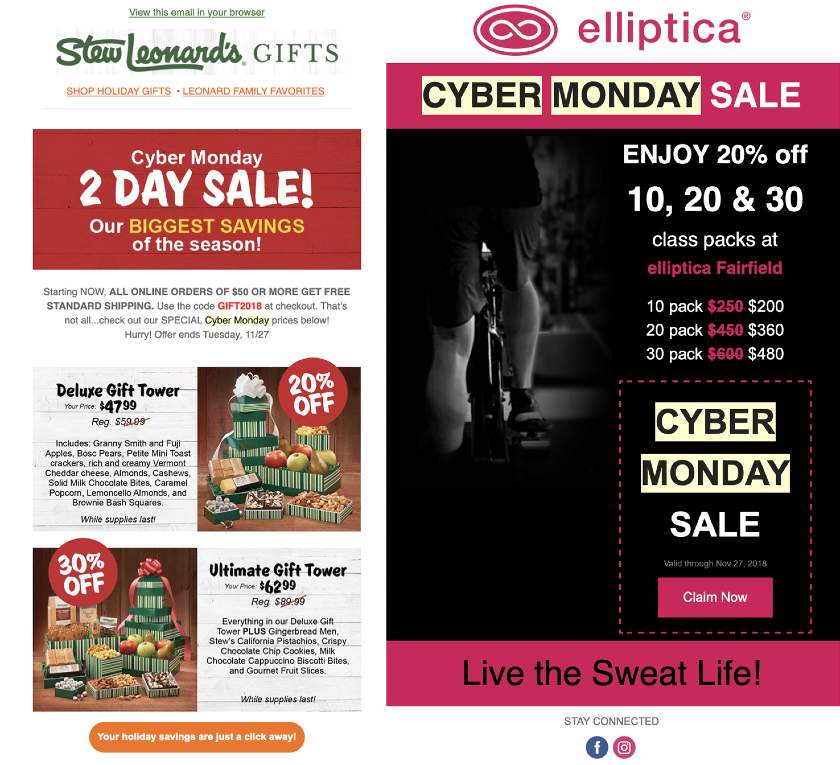
Cyber Monday promotions aren’t exclusively for traditional retailers. Grocery stores, fitness studios, and more can capitalize on the shopping momentum with promotional emails
3. Provide an Easy Shopping & Buying Experience
So you’ve attracted shoppers to your site with targeted advertising campaigns and irresistible promotional offers. What’s next?
You need to make sure you’re providing shoppers with an easy-to-use, enjoyable, and frictionless shopping experience. Doing so minimizes bounce rate and shopping cart abandonment—which in turn maximizes conversion.
Make Your Website Shoppable
Make sure your online store follows our recommended ecommerce website design principles. Here are a few simple steps you can take to improve your site’s user experience for Cyber Monday:
- Optimize for mobile. Ecommerce is steadily shifting toward M-commerce (or mobile commerce), with more and more shoppers making their purchases from a phone or tablet. Since the majority of shoppers browse from their phones, all of the website themes should already be fully responsive for mobile and include a built-in mobile shopping cart.
- Prepare for an increase in website traffic. Since you are going to do full-on Cyber Monday marketing, the last thing you want is to lose sales or have frustrated customers because your site crashes. Most ecommerce platforms run on systems that quickly respond and adjust to traffic demands. To be safe no matter what platform you use, though, contact your provider and ask for flexible bandwidth so your site can handle any traffic spikes that come your way.
- Put deals front and center. Don’t make shoppers hunt for your promotions once they’re on your site—they may quickly lose interest and head to a competitor. Put your Cyber Monday promotions front and center on your homepage and along top and side banners throughout your site.
- Offer price comparisons and show markdowns. To provide more incentive to buy, help your customers out by comparing prices and deals across your site. To take it up a notch, you could even compare industrywide prices to show how your brand is offering the best value deals on top-quality products.
- Play up your reviews. Having reviews displayed on your site allows shoppers to see past customers’ positive opinions of your brand. Instead of scrambling to get additional online reviews before Cyber Monday, make the most out of the ones you currently have. Try labeling certain items as a “five-star product” if they have five-star reviews. Put positive reviews and testimonials right in your product description for promotional items.
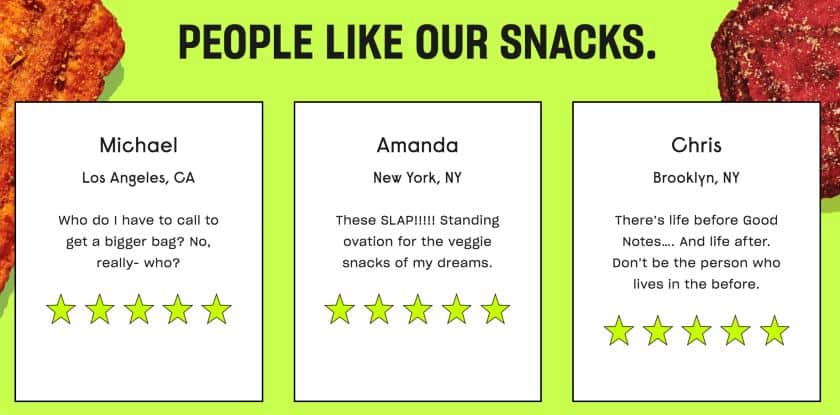
The snack company Good Notes displays customer reviews to help shoppers purchase with more confidence.
- Add a chatbot to your online store. Adding a chatbot to your website helps ensure every visitor receives assistance, no matter how swamped your in-house employees are. Chatbots can also quickly point users to relevant products and company policies. You can also set them up to answer basic questions about shipping or product specs. Learn more about how to use chatbots for your online store.
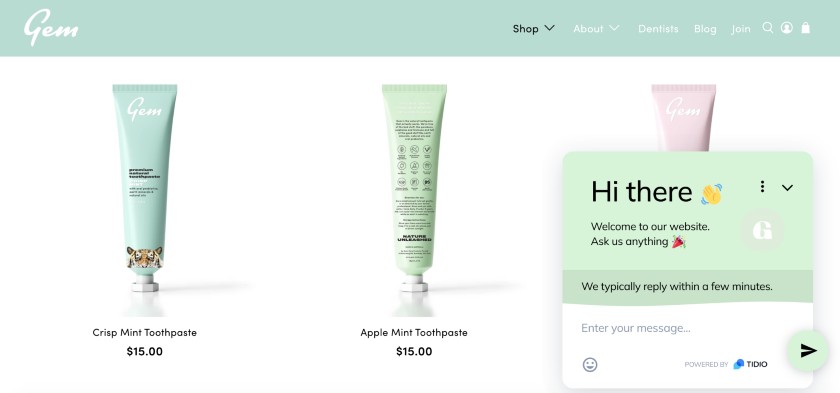
Gem has an easy-to-use chatbot for customers to ask questions.
- Ensure quality customer service. Since you are expecting a surge in demand and website traffic, prepare your staff well for the situation. If you need to hire additional temporary staff to handle the surge, go for it. You may need to update your refund and returns policy or change delivery timelines for Cyber Monday, so make sure your customer service team is apprised of any changes.
- Extend your store hours. While Cyber Monday is an online shopping event, some shoppers may discover your online promotions and want to see your products in person before making a purchase—causing a slight uptick in brick-and-mortar traffic. For that reason, it’s a good idea for brick-and-mortar retailers to extend their store hours and ensure enough staff members are on duty to help customers in person. Consider extending your hours throughout the following week too for those shoppers who missed out on a deal.
Make Checkout a Breeze
Getting customers on your site and clicking “Add to Cart” is only half the battle. On average, around 70% of online retail orders are abandoned altogether. And cart abandonments during shopping holidays tend to be even slightly higher.
Learn how to further optimize your checkout page with our checkout optimization tips, and read below for some strategies on reducing cart abandonment rates on Cyber Monday:
- Be clear on promotional pricing. About 17% of shoppers abandon a cart if they can’t calculate the order total upfront, while 47% of shoppers abandon carts because of high or unexpected fees such as taxes or shipping. To prevent customers from losing interest because of unexpected costs, be specific with your pricing language. That way, you eliminate the risk of misinterpretation or shoppers getting frustrated and leaving their order.
- Employ a one-page checkout and allow guest checkouts. One-click checkouts like Shop Pay make checkouts happen in seconds because it doesn’t require customers to enter their information anymore. If your ecommerce platform doesn’t have that feature, look for a feature that allows customers to save their information on their customer account for their next purchase.
- Offer multiple payment options. In addition to accepting all major credit cards and offering BNPL, it’s helpful to accept PayPal and Apple Pay too. That way customers don’t have to enter their credit card information if they prefer not to.
- Set clear expectations on shipping and delivery timeframes. Be sure to offer a wide variety of shipping methods: ground shipping, two-day shipping, and overnight shipping with clearly labeled pricing for each. Also, be sure to provide estimated arrival dates or at least timetables for when shoppers can expect their order to arrive. (Related: FedEx vs UPS vs USPS: Which carrier is best for small businesses?)
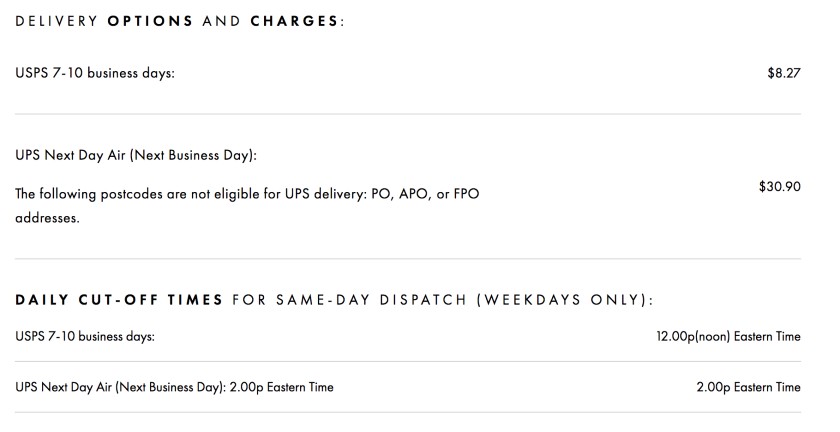
Beauty Pie makes it easy for customers to see when they can expect their order.
- Establish and display your return policy throughout your site and in checkout pages. Baymard’s survey reveals 12% of shoppers abandon carts because of an unsatisfactory return policy. This number is likely even higher during the holiday season when items are being purchased as gifts. It’s crucial to have a clearly stated return policy so that shoppers know what to expect. Include the return policy on your checkout screen and in all digital receipts. Additionally, it’s worth considering a more lenient policy for the holiday season. If shoppers are buying Christmas gifts on Cyber Monday, the recipient won’t even be given the gift until almost 30 days later. Offer at least a 60-day window to ease shoppers’ minds and minimize customer service issues.
- Send abandoned cart email reminders to retarget lost customers. Many major ecommerce platforms like Shopify have features that automatically send out emails to lost customers with links back to their abandoned cart. Think about setting up retargeting email sequences to arrive toward the end of the day. That way you’ll capitalize on those last-minute converters.

Lorna Jane sends personalized emails containing cart items to encourage people to purchase.
4. Offer Convenience Services
The rise in contactless experiences during the COVID pandemic sparked an enduring demand for convenience services. Even as shoppers are feeling more comfortable returning to stores, options like Buy Online, Pick Up In-store (BOPIS), Buy Now, Pay Later (BNPL), and contactless payments are in high demand.
Embrace customers’ preferences and make the shopping experience as comfortable as possible by implementing these services. And make sure to promote them alongside your deals and offers, so interested shoppers will know that the options are available.
- Set Up BNPL. Between 2020 and 2021, BNPL revenue increased by 21%. Since most shoppers would want to take advantage of the deep discounts but would like options to space out payments, BNPL is an excellent way to make it a win-win for everybody. Shoppers can shop more (without having to worry about having enough payment for now) and you can boost sales. Learn how to offer customer financing and explore our recommended top BNPL apps.
- Embrace click and collect. Last year, 18% of online orders on Cyber Monday were from buy online, pick up in-store (BOPIS). By embracing options like click and collect (also referred to as ‘BOPIS’), you’ll show customers you’re willing to make life easier for them and go the extra mile. Learn how to set up click and collect for your store.
- Effect contactless payment options. Cyber Monday is an online event, so contactless payment is a given; however, if you’re also offering some in-store promotions, make sure you have several contactless or NFC payment options like Apple Pay and contactless bank cards.
5. Earn a Lifelong Customer
Cyber Monday is a great opportunity to get in front of new customers. Ideally, these customers will continue to buy from you long after the holidays are over. When compared to new customers, existing customers are 50% more likely to try new products and typically spend 31% more on average—so it’s important to hang on to previous customers.
Here are a few Cyber Monday strategies to increase customer retention:
- Provide stellar customer service. Roughly 50% of customers say they would switch to a new brand after one bad customer service experience. Most customers (93%) are likely to make repeat purchases with companies that offer excellent customer service.
Having top-notch customer service is vital, especially for small online businesses where customers don’t see you in person, and you don’t have the credibility of a large brand to stand behind. Some simple ways to provide great online customer service are:
-
- Have a phone number on your website with real people answering calls.
- Take no longer than one day to answer emails; ideally, answer all customer emails within a few hours.
- Send confirmation emails after shoppers make a purchase detailing their items, costs, and expected delivery date.
- Send another email once the order ships; alerting customers during each step of the process adds transparency and helps build trust.
- Collect contact information for future campaigns. Keeping in touch with customers allows you to inform them of new products, promotions, or other news they might be interested in. Most online stores have some type of box or form for customers to sign up for a newsletter.
Change up your email sign-up verbiage so that it’s more exciting than “Sign up for our newsletter.” Try something like “Like what you see? Get more great deals year-round.” Or, offer an incentive for signing up, like an additional discount code. Then, of course, follow through with your promise of great deals by sending out emails with additional holiday sales and new year promotions.
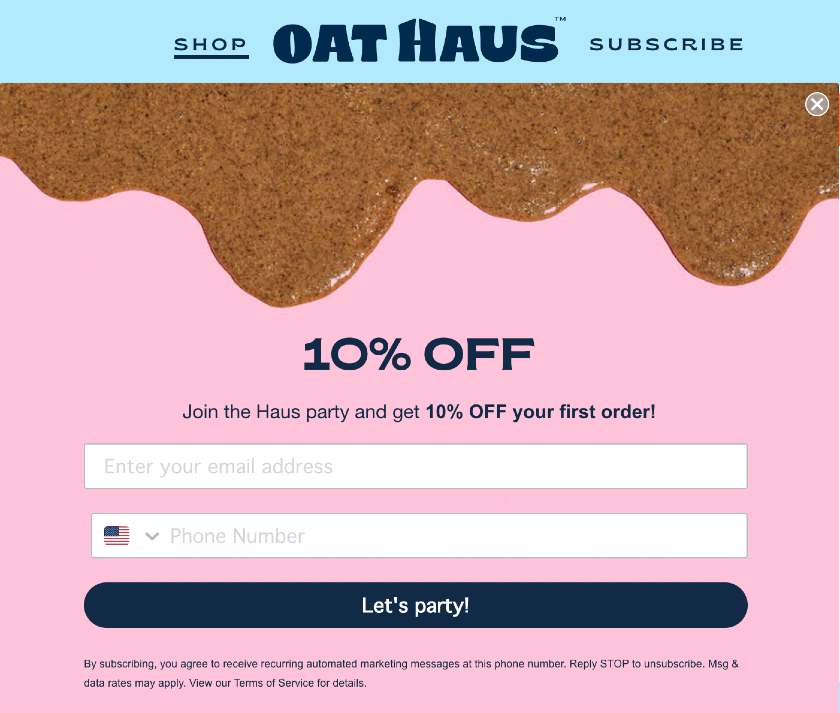
Oat Haus offers 10% off to newsletter subscribers.
6. Prepare for Next Year
Hopefully, by following all of these tips, you’ll experience record-breaking Cyber Monday sales. But—believe it or not—once the holiday season is over it’s already time to start planning for next year. You can never prepare too early. And starting preparations promptly will get you ahead of the competition.
Here are some Cyber Monday strategies to prepare for 2024:
- Beef up your social media brand presence. Take the same concepts you used to create your Cyber Monday sales posts and use them to showcase your products year-round. By scheduling your social media posts ahead of time, you can keep an active page by just investing a few hours a week. More followers on social media equals more eyeballs for your next Cyber Monday ideas for promotion. So, work on building followers throughout the year so that next year’s promotions have an even greater impact.
- Gather more user reviews. Online reviews are social proof and help build trust among consumers. Nearly 50% of consumers say they trust the reviews they read online as much as personal recommendations. Reviews also help shoppers understand what makes your product or service stand out from the competition. Learn more about how to use these reviews in our ultimate guide to user-generated content for ecommerce.
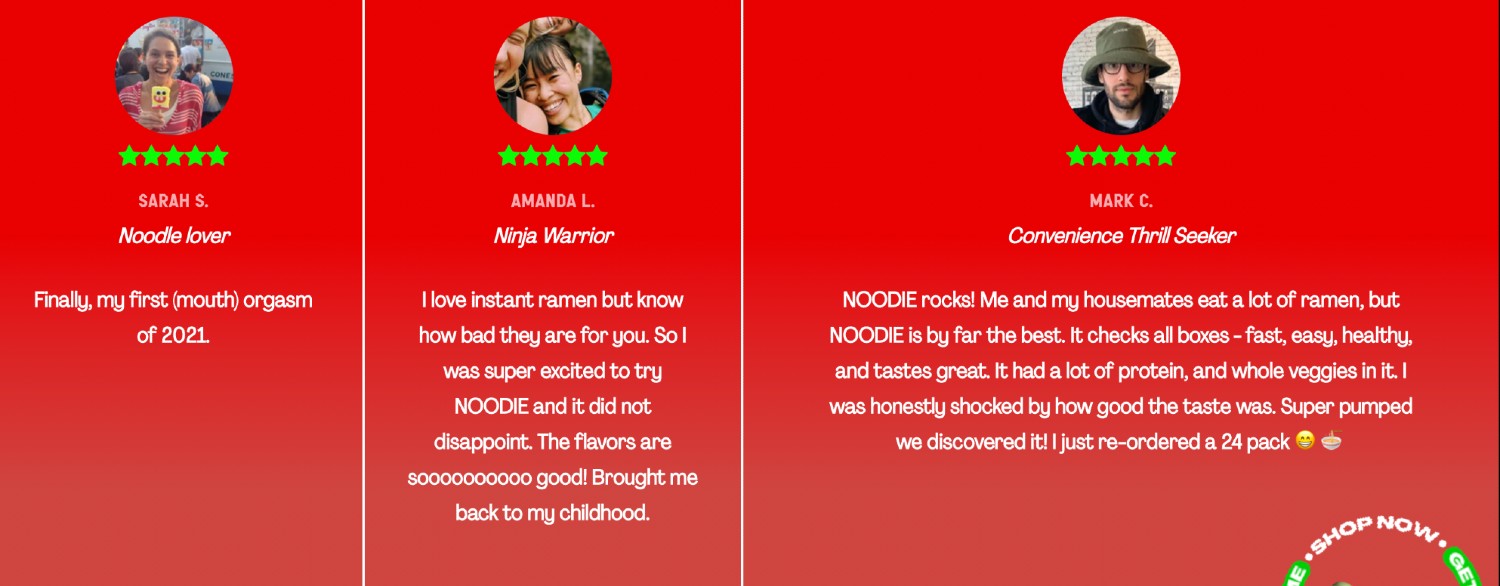
Noodie displays positive customer reviews across their site.
See our roundup of key Cyber Monday statistics from last year to glean insights on trends for this year’s upcoming holiday season.
Bottom Line
Last year’s Cyber Monday numbers clearly show how important this holiday event is for retailers and online merchants. Among the key dates, online shopping is over 3x more popular than in-store shopping for Cyber Monday. This makes Cyber Monday a prime day for online offers and launch promotions.
Standing out from the crowd on Cyber Monday isn’t always easy, especially as a small business. You need to have clear Cyber Monday strategies and make your offers irresistible to your target audience.
Effective advertising, compelling deals, and a smooth shopping experience are all essential components of a successful Cyber Monday. Approach Cyber Monday with a step-by-step strategic approach and see what results you can drive.